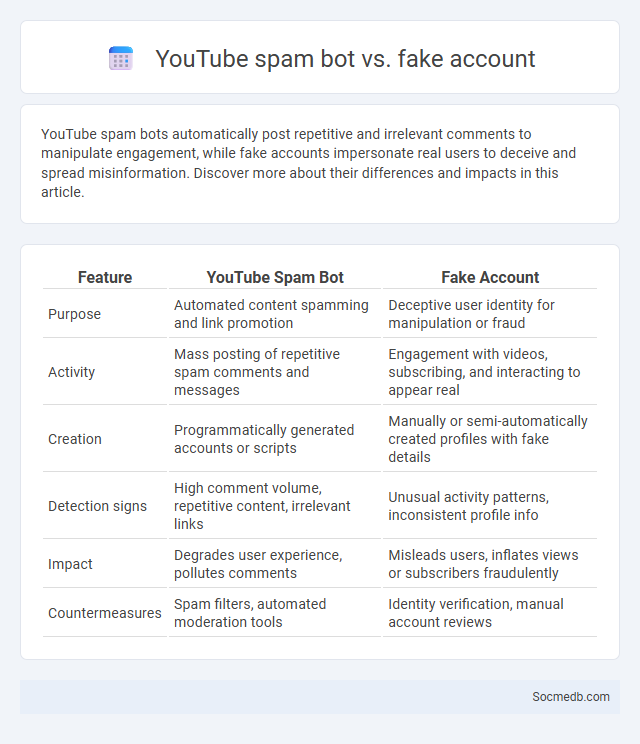
Photo illustration: YouTube spam bot vs fake account
YouTube spam bots automatically post repetitive and irrelevant comments to manipulate engagement, while fake accounts impersonate real users to deceive and spread misinformation. Discover more about their differences and impacts in this article.
Table of Comparison
| Feature | YouTube Spam Bot | Fake Account |
|---|---|---|
| Purpose | Automated content spamming and link promotion | Deceptive user identity for manipulation or fraud |
| Activity | Mass posting of repetitive spam comments and messages | Engagement with videos, subscribing, and interacting to appear real |
| Creation | Programmatically generated accounts or scripts | Manually or semi-automatically created profiles with fake details |
| Detection signs | High comment volume, repetitive content, irrelevant links | Unusual activity patterns, inconsistent profile info |
| Impact | Degrades user experience, pollutes comments | Misleads users, inflates views or subscribers fraudulently |
| Countermeasures | Spam filters, automated moderation tools | Identity verification, manual account reviews |
Understanding YouTube Spam Bots
YouTube spam bots flood comments and messages with irrelevant links and repetitive content, disrupting genuine user interaction and damaging your channel's credibility. Recognizing patterns such as generic usernames, rapid posting frequency, and off-topic comments helps identify these automated bots. Implementing advanced filters and monitoring tools enhances your ability to maintain a clean, authentic community on your YouTube platform.
Defining Fake Accounts on YouTube
Fake accounts on YouTube are profiles created with the intent to mislead, often used for spam, misinformation, or artificial engagement such as fake subscribers and views. These accounts typically lack genuine personal information or consistent activity patterns that reflect authentic user behavior. Protecting Your channel and online reputation involves identifying and reporting these fake accounts to maintain a trustworthy platform ecosystem.
What Are General Spam Bots?
General spam bots are automated programs designed to distribute unsolicited content across social media platforms, often targeting large audiences to promote scams, phishing links, or malicious software. These bots create fake accounts or hijack existing ones to flood feeds with repetitive, irrelevant messages that degrade user experience and platform integrity. Social media algorithms continuously evolve to detect and limit the reach of general spam bots, but they remain a persistent challenge due to their adaptability and scale.
Key Differences: YouTube Spam Bots vs. Fake Accounts
YouTube spam bots automatically generate and post irrelevant or repetitive content to manipulate video metrics, often flooding comment sections with promotional links or misleading information. Fake accounts, however, are manually or semi-automatically created profiles designed to impersonate real users, engage in deceptive interactions, and artificially boost channel popularity or subscriber counts. Understanding these distinctions helps You protect your channel against targeted spam and fraudulent activity.
How Spam Bots Operate on YouTube
Spam bots on YouTube operate by automatically generating and posting repetitive comments or messages, often containing misleading links or promotional content, to gain visibility and manipulate engagement metrics. These bots use scripts to exploit popular videos and trending topics, increasing the chances of their spam reaching a larger audience. YouTube employs machine learning algorithms to detect patterns of spam behavior, including rapid comment posting and link repetition, to mitigate the impact of these bots on the platform.
Identifying Signs of Fake Accounts
Detecting fake social media accounts involves scrutinizing profile details such as inconsistent or overly generic photos, minimal personal information, and suspicious follower-to-following ratios. You should examine the account's activity patterns, including repetitive posts, automated responses, and engagement spikes that don't align with genuine user behavior. Verifying connections with trusted networks and using reverse image searches can further help confirm the authenticity of profiles.
The Impact of Spam Bots on YouTube Community
Spam bots flood YouTube comments with irrelevant and repetitive content, disrupting authentic user engagement and diminishing the overall quality of discussions. These automated accounts manipulate video metrics by inflating views or likes, which can mislead viewers and creators about a video's popularity. YouTube's ongoing implementation of advanced machine learning algorithms aims to detect and remove spam bots, but their persistent evolution challenges the platform's efforts to maintain a genuine and trustworthy community environment.
Strategies to Detect and Block Spam Bots
Effective strategies to detect and block spam bots on social media include leveraging machine learning algorithms to identify unusual activity patterns and deploying CAPTCHA challenges during account registration to prevent automated sign-ups. Integrating IP blacklists and behavioral analytics helps flag suspicious accounts exhibiting repetitive posting or message flooding. Continuous monitoring combined with user reports enhances the accuracy of spam detection, maintaining a safer and more authentic social media environment.
YouTube’s Policies Against Spam and Fake Accounts
YouTube's Policies Against Spam and Fake Accounts strictly prohibit deceptive practices such as artificially inflating views, likes, or subscribers through automated systems or false identities. These policies protect your channel's authenticity by removing fake accounts and disabling content that misleads users or manipulates engagement metrics. Understanding and adhering to these guidelines maintains your channel's credibility and fosters a genuine YouTube community.
Best Practices to Protect Your Channel from Spam Bots and Fake Accounts
Implementing strong verification methods like two-factor authentication and CAPTCHA effectively reduces the risk of spam bots infiltrating social media channels. Regularly monitoring user activity with AI-powered tools helps identify and block fake accounts before they can cause harm. Maintaining strict privacy settings and educating followers about phishing scams further safeguards the integrity of your social media presence.
 socmedb.com
socmedb.com